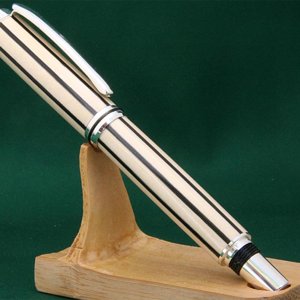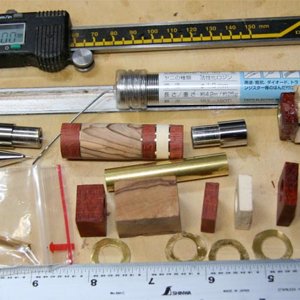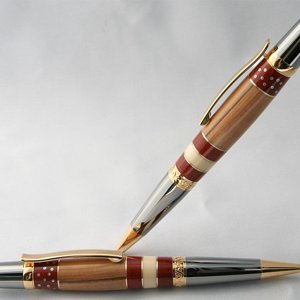Eric is right on!
There is a problem with drilling which happens when one is not completely familiar and experienced in woodworking and drilling: the integrity of the blank is already compromised by its smallness and thinness. Drilling blanks is not just plain drilling! An inexperienced person does not often realize the complications.
FOR INSTANCE:
1. Take a 2x4 pine board about a foot long. Drill a 3/8 inch hole as fast as you can. NO Problem. It works!
2. Drill a hole into the end grain as far as the bit will go, and do it fast. No problem
3. Take a 3/4 inch square pine blank (same board) 5 inches long and drill the same 3/8" hole lengthwise, at moderate speed holding it with pliers. 1 or 2 of 3 times it will blow out.
QUESTION: Why does the 3/4' square blank blow out when the same pine as a 2x4 not blow out? Simple answer - the amount of wood around the hole in the 2x4 keeps the integrity of the board intact. A 3/4" blank does not have the reinforcement of a full sized board.
A 3/4" square blank of any kind can not be drilled the same as a full size board. It does not have the integrity strength. Too many people do not understand this concept. A 3/4" blank is NOT the same as a full size board. It requires different thinking and more caution.
That is why I have used CA'ed thread or gauze to cover a delicate blank. (The adding of strips on 4 sides as Ken B does - is the same in adding strength) Understanding the dynamics of a compromised blank (thinness) and the potential of a blowout and why they occur is necessary and helpful.
Great info, Hank!
To get down to the actual forces involved, to add to the scale/size factors. When drilling, there are THREE key forces involved, at least that I've learned.
1. There is the pressure at the tip of the bit, pushing into the material.
2. There is the pressure outwards from all the material filling up the flutes, along the entire length of the bit.
3. There is the pressure outwards from the bit itself expanding due to the heat of friction.
I guess technically, the pressure from the material in the flutes is both outwards, and also angular since the bit is rotating. So #2 here could actually be both force #2 and #3, and heat expansion being #4. Anyway...these are the forces that are working to push your blank apart from the inside.
For dealing with force #1, as has been mentioned before, you can always leave your blank a bit longer than necessary (and for a segmented blank, I guess what you could do is glue on an extra piece of sacrificial wood that you would ultimately just sand or trim off during final blank prep?) This then allows you to drill as deep as necessary to drill through the part of the blank you intend to keep and t urn, without actually turning through the entire length of the blank. When the bit is drilled entirely through a blank, and exits the other side...as the material on the other side gets thinner, the pressure from you pushing the bit through the material will eventually push through that thinning material. This is generally what causes the blowout on the back side of the blank. You can also deal with this by simply being extremely careful and attentive, and slowing down your drilling, so that you cut through that final thin amount of material with less force/pressure.
Interestingly, for countering #1 in very hard and brittle materials, I have actually found that a bradpoint bit is BETTER. I know this goes against what seems to be the most intuitive sense, but it is actually BECAUSE a bradpoint cuts at the outer edge, rather than from center to edge, that it becomes easier to cut a clean hole all the way through a hard and brittle material (i.e. truestone, inlace) without blowout. The pressure is at the very tips of the front of the bit, and again with care, you cut at the extents of the hole, and any crushing or crumbling of material tends to happen in material that is being removed. The better solution is still to leave some extra length and not drill through the entire length of the blank, but in any case where that ends up not being possible, a bradpoint will usually cut a better exit hole than more traditional bits.
Finally, as with any tool-to-wood (or resin) work, there is a general rule of thumb that works well: Don't force it. Drill at a reasonable pace, don't force the bit into the wood. Just as you should let the wood draw a bowl gouge through a bowl blank at whatever rate it chooses to, which helps avoid tearout and produces a cleaner cut, don't force the bit into a pen blank. Drill at whatever pace the blank wants you to. You can generally get a sense for this...you shouldn't need much force, and the rate of the bit through harder materials will be slower than through softer materials. You should also find that, as long as you are not using too much inward pressure, material should always flow reasonably well out of the flutes. If you use too much inward pressure, the flutes will often back up very quickly, and that flow of waste material will slow or stop. That is a good sign you are trying to drill too fast. I don't drill super fast, but, at the same time, I've never spent more than 10-15 minutes drilling a blank (I've read threads in the past where people say they need as much as an hour to drill a blank...I don't think that should generally be necessary).
For dealing with force #2, this is why experienced turners will tell you to regularly clear the flutes. You don't want material to pack up in the flute. Even when that material seems to be "flowing" out on its own, as you get deeper into the blank, you still need to keep backing the bit out to clear the flutes, to minimize the pressure of that material. All that material, whatever it is (wood, resin, metals, etc.) wants to expand in every direction it can...that means back up the flute, yes, but mostly it means outward from the channel of the flute, into the wall of the very hole you are drilling. It doesn't take much for that pressure to cause problems. It is also this backup of material in the flute and the pressure from it, that can make a bit hard to extract from the drilled blank. So, keep the flutes clear!
An added technique I often use myself, is to keep some air blowing into the flutes. This creates an air pressure pocket inside the hole that does two things: It helps evacuate the waste material building up in the flutes, and it also keeps the bit cooler for much longer. It still heats up, but not as fast, and does not expand as much.
In fact, this is probably some of the problem I've had... It is not so much my bit catching at the tip, I don't think...I suspect that when a segment comes loose, it is because of that outward and radial force of the material in the flute. There is so much more surface area contact involved there, than just at the tip of the bit. It may also be that when I back out the bit to extract, maybe the force of the material in the flute is enough to pull segments apart..... Hmm...
Anyway, on to force #3, heat expansion. This happens rather quickly. Doesn't take much once more of the bit is fully within the blank for friction, from the bit on the wood, and the waste material moving through the flutes, to heat everything up. This is usually where that screech will come from. An expanding bit will start to scream at you as it expands. Usually the tip of the bit is slightly larger in diameter than the rest of the flutes, but as the bit expands, more and more of the bit will contact the inside surface of the hole, and create a screaming or screeching sound. You need to keep your bits cool. A really hot bit can even melt resin-based waste material (or even start burning wood chips), which can cause other problems. Melted resin can stick to the inside walls of the hole, and that can cause other issues. If allowed to cool, it may stick.
As mentioned before, I often use some air pressure blasted into one of the flutes to keep the bit cool, and help evacuate material. Further, when I back the bit out, I'll use that same airflow to cool the bit as well. I generally aim for a "can touch the bit with my bare finger without feeling the need to yank it back from burning" temperature in the bit, before I get back to drilling. I think using air to help cool the bit can help expedite the drilling process, despite the challenges, which may be why it usually doesn't take me terribly long to drill. I've actually been trying to figure out a way to set up some kind of multi-nozzle contraction that I could just attach to my lathe, so that when drilling blanks, I don't have to manually hold my air hose and point the nozzle.

Haven't figured out a design that works just yet.
Anyway...the three forces that make drilling hard. Account for them, and it should become easier.
1. Don't push too hard and let the drill move through the material at its own pace.
2. Don't let material pack up in the flutes, keep them clear and flowing.
3. Don't let the bit overheat, keep it cool to a "won't burn fingers" level.



